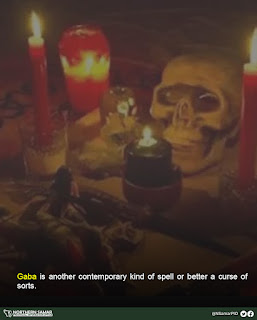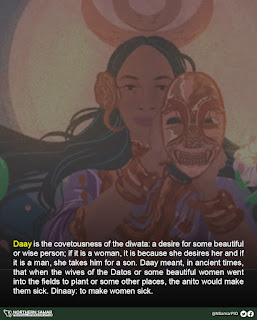The early ancestors of the Bisayans interacted with the Good Spirits and sought their assistance and made heroic attempts to appease the Evil Spirits so as to keep harm, sickness and bad fortune distanced.
They also have the `Living Temple' the Nunok (also known as the Dalakit, Baliti) Tree, where the (priestess) Bailana/ babaylan encountered their Bisayan `god' Diwata, whose Bisayan names are: Malaon, Makapatag, Badadom and Makaubos. The four different, rich and highly meaningful names all refer to the One Bisayan `god', popularly known throughout ancient Philippines as the Diwata.
The Bisayans, as well as the Filipinos in general, had no stone temples standing anywhere. Yet they were and are a spiritual, a religious people. Their places of worship were always made of fragile materials; these were quickly assembled for worship, sacrifice or some observance and then left to disintegrate just as quickly. Early missionaries who compiled Vocabularios, mentioned huts, houses and places of worship in their entries such as: the lantangan, salakan, pinto where their sacrifices (paganito) were ritualized. What more, one of the most ancient Filipino temples — a `Living Temple' — still stands, grows and thrives on many of the Philippine Islands. It is the celebrated Nunok (or Baliti, Dalakit) Tree.
THE ANCIENT BISAYAN `GODS': MALAON or MAKAPATAG, BADADOM and MAKAUBOS
The more perceptive Bisayans would say that the God that the Jesuits preach seems to be the same God they believe in and cherish. That He might be one of those whom their ancestors pointed out as the beginning of all things and creator of the world. They also acknowledged that their God was much more than just human and that people did not create themselves but were made by another. Alcina, then, knowing the Bisayan's human creation story — how the first man and woman had their beginning in the two coconuts or the two split-knots of bamboo — could not understand why the Bisayans gave such a low beginning to the first man and woman'. Nonetheless, they affirmed that this was the work of Someone who existed before them.
One of these names was Malaon which means `the Ancient One' something reminiscent; One whom acknowledged as the most exalted and most powerful. Those better acquainted with the matter in our days, think that this One is the true God whom the early missionaries preach to them.
UMALAGAD: THE ANCIENT BISAYAN SPIRITS
Regarding the evil and good spirits, Alcina find an even more solid basis to believe and to understand that the Bisayans had a greater knowledge of these than other things and even about life-hereafter. These spirits they called Umalagad, a word in which in their language means `something that follows or goes along with'; a guardian, or a spirit.
The Bisayan spirits, called humalagad, were composed of two classes: the good spirits who accompanied a person and did good; while the others were considered evil spirits who sought out evil and misfortunes for people. It was the latter, Alcina writes, that the Bisayans feared most and made great attempts in appeasing them by means of various paganito or paglihi.
Bisayans believed that the umalagad were the souls of their deceased ancestors and they had recourse to them for help in various needful situations. Just as the Bisayans would turn to the Diwata and say: "Kon buot san Diwata" ("If god so wishes"); so too, they turned to the umalagad saying "Kon Buot san Umalagad" ("If the souls of deceased so wish it"). When the Bisayans were sick, the Baylana or Daitana would urge them "Mangaraba sa Diwata/ umalagad". The Bisayans begged favors from all sorts of dead; either recently deceased or even those who were dead for a long time, just as long they were relatives. There is no doubt that the Bisayans practiced this way of praying to their deceased; understood it in this manner. This is indicative that the Bisayans believed in life after death by cultivating recourse to their deceased.
-------------------------------------------------------------------
References:
Alcina, F. (2005). History of the Bisayan People in the Philippines Islands. UST Manila: UST Publishing House.
Kobak, C. (2002). Ancient Pre-Hispanic Concept of Divinity, the Spirit-World Sacrifices, Rites and Rituals among the Bisayans in the Philippines in Philippiniana Sacra. UST Manila Graduate School Publication.
Scott, W.H. (1994). The Spirit Underworld in Barangay: Sixteenth Century Philippine Culture and Society. Ateneo de Manila University: Ateneo Press.
For more news and updates, visit:
►http://northernsamar.gov.ph
►http://www.budyong.com
Subscribe to our YouTube account: ►https://www.youtube.com/channel/UCRkURQbWNWtVo9rrAIdnlnA
Like our Facebook page:
►PGNS: https://www.facebook.com/PGNS.Official
Follow us on Twitter:
►https://twitter.com/nsamarpio
Subscribe to our YouTube account: ►https://www.youtube.com/channel/UCRkURQbWNWtVo9rrAIdnlnA
Like our Facebook page:
►PGNS: https://www.facebook.com/PGNS.Official
Follow us on Twitter:
►https://twitter.com/nsamarpio
Tags
History



























